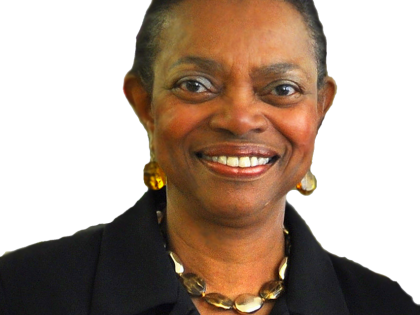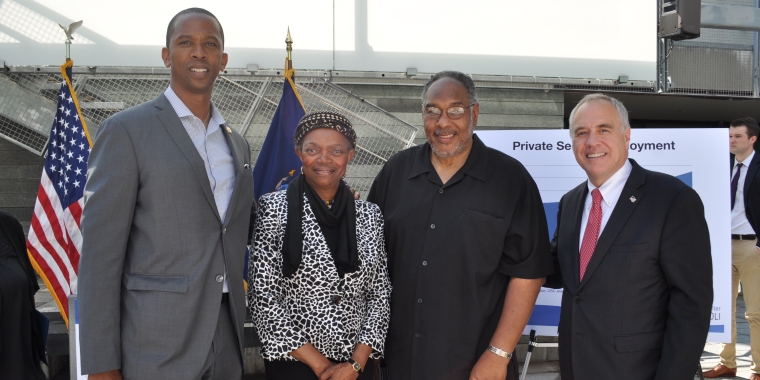
New York State Comptroller Thomas P. DiNapoli releases report "An Economic Snapshot of the Bedford-Stuyvesant Neighborhood"
Senator Velmanette Montgomery
September 14, 2017

Senator Montgomery joined colleagues and community stakeholders for the release of New York State Comptroller Thomas P. DiNapoli report "An Economic Snapshot of the Bedford-Stuyvesant Neighborhood."
NEWS From the Office of the New York State Comptroller Thomas P. DiNapoli
September 15, 2017, Contact: Press Office (518) 474-4015
DiNapoli: Bedford-Stuyvesant is on the Rise
The Bedford-Stuyvesant neighborhood has experienced strong population, business and job growth in recent years, according to a report released today by New York State Comptroller Thomas P. DiNapoli.
"Bedford-Stuyvesant is undergoing an economic resurgence, with record numbers of businesses and jobs, but the benefits have not been shared by all residents," DiNapoli said. "Today's report shows how far Bedford-Stuyvesant has come, but it also shows the challenges that remain."
"As a lifelong resident of Bedford-Stuyvesant, its elected representative, and Chairman of the New York City Council's Committee on Small Business, I am very grateful for the Comptroller's economic report on Bed Stuy," said Council Member Robert Cornegy. "The economic growth highlighted in this snapshot shows that our long-term vision for a prosperous Bedford Stuyvesant is coming to fruition. It has required collaboration and problem-solving across multiple sectors over the course of the past five to10 years and I am encouraged by the progress evident in this report. There remains work to be done to address ongoing hurdles related to poverty, affordable housing, and healthcare, but I am confident that with the partnerships we have created and the business and private sector job growth we are experiencing, we can overcome these challenges. I am committed to ensuring that the economic prosperity of this community benefits all its residents and excited by the promise of our vision for a vibrant, thriving Bedford-Stuyvesant."
"Bedford-Stuyvesant is a proud community with boundless potential, one where we must ensure that growing popularity translates into widespread prosperity for longtime residents," said Brooklyn Borough President Eric L. Adams. "I thank Comptroller DiNapoli for shining a needed spotlight on this historic Brooklyn neighborhood, a safe place to raise healthy children and families."
"I am so proud to represent Bedford-Stuyvesant, which has always been a vibrant and politically engaged community," said State Sen. Velmanette Montgomery. "I am happy Comptroller DiNapoli recognizes how the changing landscape impacts current residents who are struggling to remain after building this community. The information provided in this report is extremely valuable. I hope it will help shed light on how the resources of New York state can be used to help maintain affordability and address the many challenges that arise in rapidly gentrifying areas."
"Over the last two decades, the Bedford-Stuyvesant community has experienced major economic growth and development as local businesses thrive, and jobs multiply," said Assemblymember Walter Mosley. "This boom in the economy had simultaneously occurred with the growth of Bed-Stuy's flourishing population. While this economic upturn has surpassed the city's overall rate of economic expansion, the Bedford-Stuyvesant community is experiencing skyrocketing housing costs, lack of affordable housing, an increase in poverty and healthcare challenges for many of our citizens as a result. As elected officials, we must ensure that our most vulnerable constituents are not left behind in good times, and in bad. As John F. Kennedy once said, ‘A rising tide lifts all boats.'"
"As the Assemblymember for this area, a homeowner and a former business owner I am very happy to have this official economic snapshot of Bedford-Stuyvesant completed and indicative of growth," said Assemblymember Tremaine Wright. "The guided information and outlook provided to us from the Comptroller's office will be beneficial as we come together as community and plan for the future of our Bedford-Stuyvesant."
"Comptroller DiNapoli's Economic Snapshot of Bedford-Stuyvesant confirms what local residents and business owners have been witnessing and experiencing over the past several years. New residents are flocking to Bedford-Stuyvesant and other Central Brooklyn neighborhoods," said Colvin W. Grannum, President and CEO of the Bedford-Stuyvesant Restoration Corp. "New businesses are setting up shop in Bedford-Stuyvesant and attracting a diverse range of patrons. These promising developments have a downside because many low- and moderate-income families can no longer afford to live in Bedford-Stuyvesant and partake in the growing vitality. This is also true of many small business owners. Many residents don't have the skills to secure employment in the new businesses. The challenge ahead is to intentionally put in place housing and economic development initiatives that create an equitable economy in Bedford-Stuyvesant and across Brooklyn – an economy that benefits all residents and business owners regardless of race or income. We must all come together to ensure that new investments whether in housing or business are crafted to be inclusive and welcoming to all."
"With its rich history and commercial corridors idealized by music artists, movie-makers and more, it's no surprise that Bed-Stuy is thriving," said Brooklyn Chamber of Commerce President and CEO Andrew Hoan. "It's one of Brooklyn's most attractive neighborhoods with its beautiful brownstones, cultural institutions and diverse residents. Kudos to Comptroller DiNapoli for putting the spotlight on this great neighborhood."
"Although Bedford Stuyvesant is known for its rapid economic expansion, one cannot overlook the residents that are facing hardship and still struggle to put food on their tables as food insecurity still remains a huge problem," said Dr. Melony Samuels, Executive Director Bed-Stuy Campaign Against Hunger.
The number of jobs in Bedford-Stuyvesant increased by 45 percent since the end of the recession in 2009 to a record 17,000 jobs in 2016. The retail trade and the leisure and hospitality sectors registered the largest job gains, with each sector accounting for about one-fifth of the 5,300 jobs added since 2009. Job growth has accelerated since 2010 and has exceeded 7 percent in each of the past four years.
The number of businesses increased by 73 percent between 2000 and 2015, which was the fourth fastest rate of growth among the 55 neighborhoods in New York City. In 2015, there were a record 1,910 businesses and almost three-quarters were small businesses with fewer than five employees.
The population increased by 25 percent between 2000 and 2015 to 150,900, more than three times faster than the citywide rate of growth. The ethnic and racial mix of the population has undergone significant change in the past 15 years as the neighborhood has attracted new residents.
Many of the new residents are immigrants, white, or young, and are likely to have higher household incomes than long-term residents. New residents had a median household income of $50,200, compared to $28,000 for long-term residents. New residents comprised one-third of the households.
There were 14,000 senior residents living in Bedford-Stuyvesant in 2015. Their household incomes were only $25,500 and 42 percent of them relied on the federal Supplemental Nutrition Assistance Program for food assistance.
The number of residents under age 18 (43,900) grew by 27 percent between 2010 and 2015, more than three times faster than the rest of the population. This segment of the population accounted for 29 percent of Bedford-Stuyvesant's population, the third-highest concentration among the city's 55 Census-defined neighborhoods.
Housing affordability is a serious problem, even though nearly two-thirds of all apartments are either rent-stabilized or public housing. The median monthly rent increased by 77 percent between 2005 and 2015, rising to $1,230. In 2015, 55 percent of all households spent at least 30 percent of their income on rent and nearly one-third devoted more than half.
Median home values (for one-, two- and three-family homes and condominiums) have risen sharply in recent years, from $484,800 in 2005 to $779,400 in 2015. The 61 percent increase was nearly twice as fast as the growth in Brooklyn overall.
Residents suffer from above-average incidences of chronic health problems. According to the New York City Department of Health, of the 59 community districts in New York City, Bedford-Stuyvesant ranks in the top 10 for smoking, diabetes, new HIV diagnoses, obesity, stroke, mental health, alcohol hospitalizations and adult hospitalizations for asthma. The average time patients waited in the emergency room before being seen for a diagnostic evaluation by a health care professional at area hospitals was higher than the statewide average.
Other findings in DiNapoli's report include:
- The share of households living in poverty has hovered at about 30 percent since the end of the recession, significantly higher than the citywide poverty rate (19 percent). Moreover, the number of households in poverty increased by 13 percent from 13,800 in 2009 to 15,600 in 2015.
- One-third of all households receive Supplemental Nutrition Assistance Program (SNAP) benefits and nearly half receive Medicaid benefits. These programs are at risk of federal budget cuts.
- In 2015, less than one-fifth of long-term residents had at least a bachelor's degree, compared with 46 percent of new residents.
- More than 20,400 people live in public housing apartments under the control of the New York City Housing Authority, the highest number in any community district in Brooklyn.
- Violent crime fell by 44 percent between 2000 and 2016, but crime remains a concern.
- School District 16, which covers most of the neighborhood, has one of the highest concentrations of homeless students in New York City.
- Traditional elementary and middle schools have shown notable improvement in English and math proficiency, but they still lag behind the citywide averages.
Read the report, download the attached PDF.
To learn more about the report, read:
https://ny.curbed.com/2017/9/16/16319382/bed-stuy-brooklyn-gentrification-nyc-report-thomas-dinapoli
Share this Article or Press Release
Newsroom
Go to NewsroomGOVERNOR CUOMO SIGNS MONTGOMERY/FRONTUS CENTRAL PARK 5 BILL
December 10, 2020
Senator Montgomery Urges Governor to Sign Central Park 5 Bill
November 20, 2020